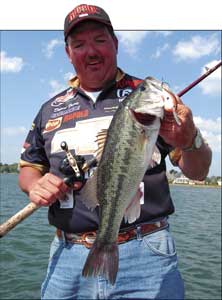
It is no secret to anyone who is familiar with my name or reputation that I love to fish crankbaits. Most of the money I’ve won as a pro bass fisherman has been with a diving bait tied onto the business end of a fishing rod.
So it should be no surprise that I absolutely love the month of June. It is the best time of the year to catch bass with a crankbait — especially the second half of the month.
Did I mention we’re talking about North Carolina?
For the most part, almost every bass that lives in a lake in North Carolina will be finished spawning by the first of June. Depending upon which lake you’re fishing, the first week of June can be tough as late spawners go through the process of recovering from their hard work on the bank. But the end of the month is great almost anywhere.
For the kind of fishing I like to do — cranking or dragging a Carolina rig well off the bank around points, humps and drops — the last half of June is the best time of the year.
What happens is after bass finish spawning, they pull out off the bank and suspend for a week or so, trying to get their equilibrium back — or whatever they’re doing when they won’t bite for a while — and then they move to the first piece of offshore structure they can find. That might be a secondary point that’s outside of a spawning pocket, or it might be a creek channel bend that runs close to the mouth of a pocket, or it might even be a good, sharp drop close to that pocket.
You’ll find them in big bays, in the creeks, outside of pockets. But they’ll stop somewhere where shallow water meets deep water. And you need to find them and follow them as they move out toward the places they’re planning to spend the summer.
June can be especially good because bass are moving, traveling the creek channels back toward the main lake, and a lot of times, you find a lot of them moving together. Then, you throw in the fact that June is a month when shad start to get balled up some, and you can really catch ’em in a hurry.
You can pull up to a little spot, and you can catch one, or you can catch 21 — if you find them in the right kind of spot, on the right kind of cover.
I start out with a Rapala DT-10 crankbait in early to mid-June, and I fish a little deeper as the month progresses. By the end of the month, I’m probably fishing a DT-14 or a DT-16. In fact, if I was limited to just a few baits for the whole month, it would be those three — in shad colors like pearl/green and pearl/blue — and a Zoom lizard.
I’m covering a lot of water with a crankbait, making long casts. Most of the time, I use a 7-foot American Rodsmiths cranking rod, but if I need to get a bait a little deeper, I can get a little more casting distance with a 7-6 or 7-11 rod paired with the David Fritts cranking series reel that Bass Pro Shops makes.
The 4.7-to-1 gear ratio is great; it takes up 21 inches per turn, but the big things are, it winds easier — it makes fishing a crankbait easier on your wrists and hands. And it doesn’t have infinity or rewind features, so it allows you to feel the crankbait vibrating, especially when you stop reeling.
But really, you can fish just about anything in June and catch bass. There aren’t too many baits in your tackle box that won’t work because the fish are hungry and aggressive.
You can start with topwaters early and move to finesse worms up in the day, then big worms. Anybody can do well slow-rolling a spinnerbait. June is an especially good time to fish really big worms on a Texas rig or Carolina rig.
I guess the only exception is an extremely shallow-running crankbait, and even then, you can fish it in the river section of a lake and catch fish.
One thing fishermen need to consider when they’re looking for fish on offshore structure as the summer approaches is the effect of current. Moving water has a lot to do with fish at this time of the year.
At lakes where they move a lot of water, you need to look at a piece of cover or structure you’re fishing and try to imagine how it is situated with respect to the current.
Very often, that can pinpoint the exact spot at a bigger area where most of the fish will be holding. That’s how you catch 21 at a spot instead of just one.
Editor’s note: David Fritts is a 50-year-old professional bass fisherman from Lexington. He was the 1993 BASS Masters Classic champion, the 1993-94 BASS Angler of the Year and the 1997 FLW Tour Champion. His sponsors include: Bass Pro Shops, Evinrude Motors, Ranger Boats, Chevy Trucks, Minn-Kota trolling motors, American Rodsmith, Rapala crankbaits and fishing line, Zoom plastics, Solar Bat sun glasses, Mountain Dew, Gripper (ECS Anchor Supply), VMC hooks, Pro Pocket and Blue Fox.




Be the first to comment